
Author and creative writing teacher Jesse Falzoi was born in Hamburg and raised in Lübeck, Germany. Back in the nineties, after stays in the USA and France, she moved to Berlin, where she still lives with her three children.
She has translated Donald Barthelme stories into German. Her own stories have appeared in American, Russian, Indian, German, Swiss, Irish, British and Canadian magazines and anthologies. She holds an MFA in Creative Writing from Sierra Nevada College.
Her new book on Creative Writing is released end of May 2017.
At the age of twenty-one I quit university and bought a one-way ticket to San Francisco, USA. I wanted to get far away from my first attempts to grow up. I wanted to get away from a frustrating relationship and boring courses and everything that was pushing me to take life more seriously. I didn’t have any plans what I would be doing in San Francisco but I had the address of an acquaintance I had made a year before. I went on a journey that was physical in the beginning and became more and more spiritual during the process. I bought a return ticket in the end and went back to my hometown just to pack my suitcases for good; I’d be staying in Germany, but I wouldn’t be staying home.
(more…)
The logline is probably the hardest sentence to write.
The logline sums up a story in one sentence. This sentence should be memorable and clear, which means it is unlikely to be much longer than thirty words or to have complex syntax.
Once your reader has read your logline – or your listener heard it –, they will ideally know the following about your story:
- who it is about
- what the central conflict or main problem is
- what the most important characters do in the story
- why they do it, i.e. what their motivations are
- how they do it
- where all this happens, i.e. what the setting is
- when it happens, i.e. what the period is
The first of these points even counts double – since usually the logline should convey not only who the main protagonist is, but also what antagonism she faces.
What’s the logline for?
The purpose of the logline is to pitch your story.(more…)
Conflict is the lifeblood of story.
In real life, conflict is something we generally want to avoid. Stories, on the other hand, require conflict. This discrepancy is an indicator of the underlying purpose of stories as a kind of training ground, a place where we learn to deal with conflict without having to suffer real-life consequences.
In this post we will look at:
- An Analogy
- Archetypal conflict in stories
- Conflict between characters
- Conflict within a character
- The central conflict
Along with language (in some form or other, be it as text or as the language of a medium, such as film) and meaning (intended by the author or understood by the recipient), characters and plot form the constituent parts of story. It is impossible to create a story that does not include these four components – even if the characters are one-dimensional and the plot has no structure. However, it is formally possible to compose a story with no conflict.
It just won’t be very interesting.
(more…)
In stories, characters are faced with obstacles.
These obstacles come in various forms and degrees of magnitude. And they may have different dimensions: they may be internal, external, or antagonistic.
Often the obstacles that resound most with a significant proportion of the audience are the ones that force the main characters to face and deal with problems within themselves, in their nature. In other words, with their internal problem.
Internal obstacles are the symptoms of the characters’ flaws, of the internal problem. The audience perceives them as scenes in which the character’s flaw prevents her progress.
Not every story features characters with internal problems. An internal problem is not strictly speaking necessary in order to create an exciting story.
But it helps.
The Emotional Truth
An internal problem makes the character appear fallible – and thus more credible, more human, more like us. Internal problems are invariably emotional and private. They express(more…)
You’re on a boat, and you see somebody fall into the water. Which of the following two cases would cause you to react with stronger emotion?
- The water is four feet deep and you know that the guy who fell in is a good swimmer
- The water is four feet deep and the person who fell in is a three year old girl who can’t swim
Presumably your emotional reaction would be stronger if the child fell off the boat. Because you know that the child’s life is at stake. The first situation is not life-threatening, the only thing at stake is the dryness of the man’s clothes and his self-esteem.
The degree you care about events that happen to people, and to yourself, is directly related to what’s at stake. This applies as much to fictional characters as in the real world.
Hence it is immensely important for storytellers to(more…)
In a story, if the treasure hoard is what the character wants, then slaying the dragon is the goal.
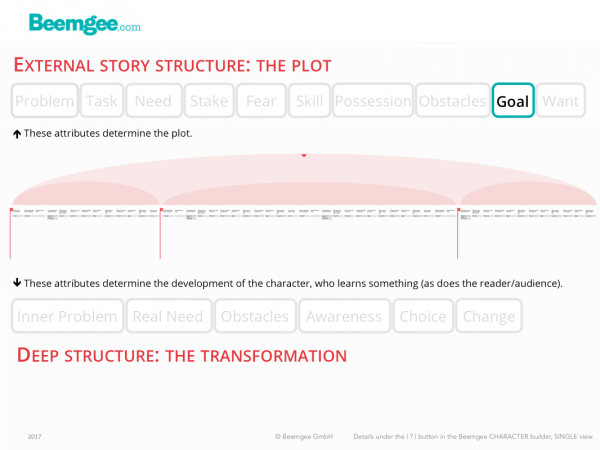
The goal is what the character thinks will lead to the want.
Since the hoard has been there for ages, there must usually be some sort of trigger for the story to get started, i.e. for the character to want the hoard now, at the time the story begins. Often, an external problem creates such a trigger. It might supply a reason why the hero needs the hoard now, something more specific than just the general sense of wanting to be rich. Perhaps the hoard isn’t the reason at all. Perhaps there is a princess in distress, which certainly adds urgency to the matter. Either way, dealing with the dragon is the goal.
If somebody says the word “goal” to you, the image that springs to mind might have to do with the ends of a football pitch. The(more…)
Stories are about people who want something.
We can distinguish between two different types of want:
- the wish, or character want
- the plot want
Marty McFly wishes to be a musician (character want). He also wants to get Back to the Future (plot want).
The wish or character want is a device which adds cohesion to the story, usually in the form of the set-up/pay-off. Marty is seen at the beginning of the film practicing the guitar; at the end of the film he plays at a concert. The wish is a useful technique to make the character clearer to the audience, but it is not essential to composing a story.
More important is what we have called the plot want. As a result of the external problem – the trigger event that sparks the chain of cause and effect which the bulk of the plot consists of –, the character feels an urge, which provides the motivation for the character’s actions in the story.
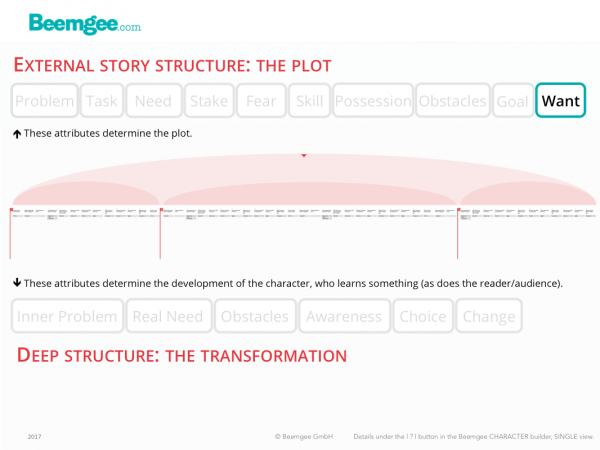
The want is the state after which the character strives, and is distinct from the goal.
In this post we’ll be talking about active vs. passive characters, motivation, the difference between a want and a goal, a couple of writer traps to avoid, and contradictory wants.
Active Characters
Characters have to be actively acting of their own volition. The want has to be urgent and strong enough for them to do things. If the want is missing or too weak, the character will lack motivation and appear passive. A passive character is usually not interesting enough to hold the audience’ or readers’ attention.
Why is this so?
An evolutionary explanation of stories as practice for problem-solving attempts to shed light on the phenomenon: When characters react to events rather than cause them, they appear weak, like victims. Which means that there is not much we can learn from them. Humans experience stories physically and emotionally (our hearts beat faster, our palms sweat), and since we learn from experience, we instinctively prefer stories which provide us with experiences that benefit us in some way. Which tends to be the case when we experience stories of self-motivated problem-solving.
Motivation
There is a good reason for that cliché about actors always asking about their motivation. It is motivation that prompts the characters in a story to do the things they do. Stories seem to work best not only when characters are active rather than passive, but often when they have comprehensible reasons for their activity.
The reason for what a character wants is usually comprehensible for the audience or reader because of the external problem. In simple terms, the character wants to solve the problem. Take the Cinderella story as an example. Her problem is that she is bound to the stepmother and her two nasty daughters.
In other words, the want is a vision the character has of his or her situation without the problem. Hence what the character wants is actually a particular state of being. Such a state might mean being in a position of wealth, power or respect, or being in a happily ever after relationship. Cinderella wants merely to be free of her involuntary servitude, if only for a little while.
This makes the want distinct from the goal, which is the specific gateway to the wanted state of being, as perceived by the character. A story usually sets up a goal the character needs to reach or attain in order to achieve the want. In Cinderella’s case, it is attending the ball.
So, a story has its characters pursue their wants. These different wants oppose each other, causing conflicts of interest. The conflicting wants make the characters active, and the audience/readers like stories about actions, that is, about characters who do things.
Sounds simple.
And yet frequently stories seem to mess up on this vital point.
Next to passive characters without a strong enough want, lack of clear motivation is a huge writer trap. It is possible to write a whole story full of characters who are reactive instead of active, or who do things of their own volition but without that volition being clearly recognisable to the audience/reader. It is perhaps even tempting to write stories like that, because they seem more lifelike. In real life, people do not necessarily have distinct goals. Often, our wants are vague and not clearly definable. What about writing a realistic story about a character with a general sense of dissatisfaction, who, like so many of us, has lost sight of any clear objective in life?
It’s doable, certainly. But the audience/readers will probably start to look for the specific want of such a character. They would probably begin to expect the story to be about this character’s search for a clear objective in life. That might be the want the audience would tacitly ascribe to the character.
And if the story does not bear such motivation out, the risk is significant. Because stories in which the audience does not understand what the characters want lack emotional impact.
Contradictory Wants
A way of adding psychological depth and emotional complexity to characters is to give them several and even contradictory wants. Gollum in Lord Of The Rings wants the ring. Yet a part of him also wants to give up the ring and help Frodo. Next to solving the case, Marty Hart in True Detective wants to be a good husband and family man, but he also wants affairs with other women. That’s three wants for one character.
Is it really always necessary for every character to have a clearly defined want?
No. Because, of course, there are exceptions. In certain cases, the author might deliberately obfuscate the why of a character’s actions in order to inject mystery. Not knowing something keeps the audience/reader guessing and turning the pages or not switching the channel. Usually this mystery is cleared up at some point. The audience tends to expect that. Which implies that even if the want was not made clear to the audience early in the story, it was there in the character nonetheless – and certainly the author was aware of it.
Injecting mystery in this way is not in itself a writer trap. But nearly. When tempted to use such a device, an author should at least consider if it would not actually be more interesting for the audience to know the character’s motivation.
Having said that, there are rare cases where a character’s motivation does remain unexplained. And those cases can be powerful. Especially when it’s a baddy we don’t understand.
Think of Iago in Shakespeare’s Othello, who is simply bad to the bone and we’ll never really know what made him so. Shakespeare – deliberately, one presumes – gives no hint as to what Iago hopes to achieve by ruining Othello. Shakespeare might easily have given Iago some clearly understandable motivation, such as revenge of a past wrong, envy of Othello’s success, desire to usurp Othello’s position, lust for Desdemona. But he didn’t. And Iago is one of the most superb villains ever.
But perhaps the most interesting thing about a character’s want is how it stands in conflict with what that character really needs.
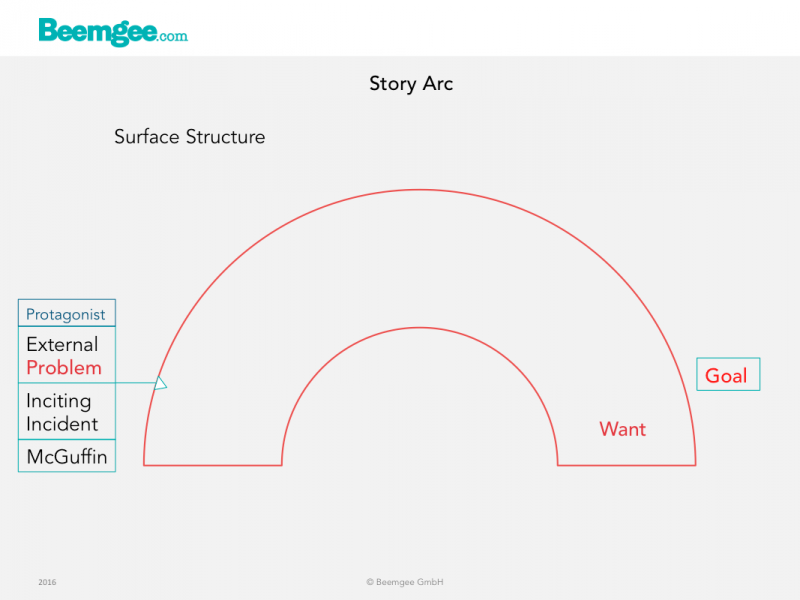
In storytelling, a McGuffin (or MacGuffin) is something that the protagonist is after – along with most other characters in the story.
The use of a McGuffin is a device the author employs in order to give a story direction and drive.
Easy to spot McGuffins are the Ark of the Covenant in Raiders Of The Lost Ark, the statuette in The Maltese Falcon, private Ryan in Saving Private Ryan, the ring (more specifically, the act of its destruction) in Lord Of The Rings. Note how in these examples, the McGuffin is in the title of the story. The McGuffin may be so deeply embedded in a story structure that it becomes what the story is about, on the surface at least.
Typical genres that have McGuffins are comedy, crime, adventure, fantasy and other quest stories. But conceivably, a dressed up McGuffin might be found in any genre.
Nor does a McGuffin have to be an object. It could be a person or a quality. In a story of several characters vying for the love of one other character, that love might be considered the McGuffin. A place might become a McGuffin too – consider the role of the planet Earth in Battlestar Galactica.
In terms of narrative structure, a McGuffin occupies the(more…)
If there is one thing that ALL stories have in common, it is change.
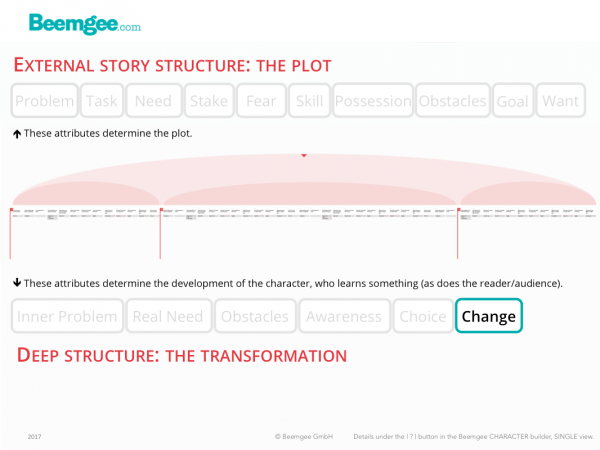
A story, pretty much by definition, describes a change. Indeed, every single scene does.
The most fundamental change that stories tend to describe is one of recognition of truth. What is not known at the beginning of the story is recognised and thus becomes known at the end. This is obvious in crime stories, but holds true for almost all other stories too. The story therefore amounts to an act of learning. Often the learning curve is observable in the protagonist, who tends to be wiser at the end than at the beginning. But the point is really that the recipient, the reader or viewer, is actually the one doing the learning – through experiencing the story.
So within a story, what changes?
At the very least,
- one of the characters, usually the protagonist
- often other characters too
- sometimes the whole story-world
(more…)
A character with a goal needs to do something in order to reach it.
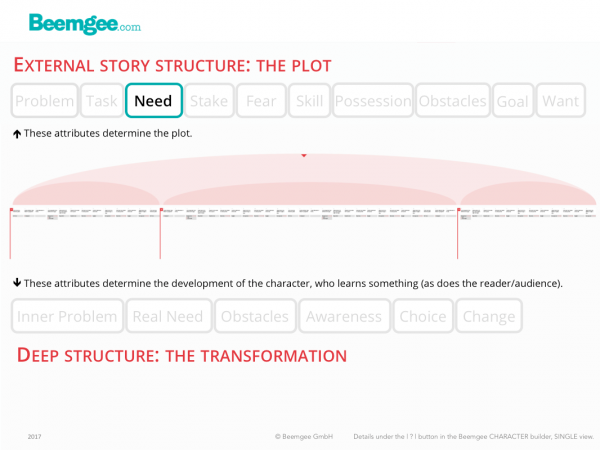
The outward needs of a character – things she needs to acquire or achieve in order to reach the goal – divide the story journey into stages.
In storytelling, characters usually know they have a problem and there is usually something they want. They tend to set themselves a goal which they believe will solve their problem and get them what they want.
In order to get to the goal, the character will need something. Some examples: If the goal is a place, a means of transportation is necessary to get there. If we can’t rob the bank alone, we’ll have to persuade some allies to join our heist. If the goal is defeating a dragon, then some weapons would be helpful. If magic is needed, we’ll have to visit the magician to pick some up.
While the perceived need might be an object or a person, it usually requires an action. We’ll need a car, so do we buy one or steal one? We’ll need a sword, so do we pull one out of a stone or go to the blacksmith? If we need help, who do we ask and how do we talk them into joining us? We’ll need magic, but how do we find a magician? Ask an elf or go to the oracle for advice?
So, once the(more…)
What’s the problem? Does the character know?
In storytelling, discrepancy between a character’s awareness and the awareness-levels of others is one of the most powerful devices an author can use. “Others” refers here not just to other characters, but to the narrator and – most significantly – to the audience/reader.
Let’s sum up potential differences in knowledge or awareness:
- A character’s awareness of his or her own internal problem or motivation
- A difference between one character’s knowledge of what’s going on and another’s
- The narrator knows more about what is going on than the character
- The audience/reader knows more than the character – dramatic irony
In this post, we’ll concentrate on the first point: Awareness of the internal problem. We’ll break that down into
- Becoming Aware – the importance of the revelation
- The Story Journey – and where to place the revelation
- Surface Structure and Deep Structure
- The Need for Awareness – or, Alternatives to Revelation
Becoming Aware – the importance of the revelation (more…)
An inner or internal problem is the chance for change.
While the external problem shows the audience the character’s motivation to act (he or she wants to solve the problem), it is the internal problem that gives the character depth.
In storytelling, the internal problem is a character’s weakness, flaw, lack, shortcoming, failure, dysfunction or mistake. If you like, it is the expression of a negative character trait. Classically, this flaw may be one of excess, such as too much pride. Almost always, the internal problem involves egoism. By overcoming it, the character will be wiser at the end of the story than at the beginning. Thus the character must learn cooperative behaviour in order to be a mature, socially functioning person.
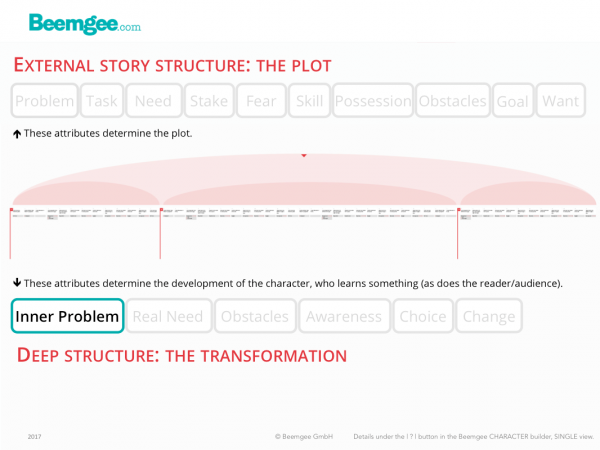
The inner problem is the pre-condition for the character’s transformation. It is the flaw, weakness, mistake or deficit that needs to be fixed. In other words, it shows what the character must learn.
Internal problems can be character traits that cause harm and hurt to others. They can be anti-social. And internal problems can also harm the character. They can be detrimental to his or her solving the external problem.
The Internal Problem of a character is revealed to the audience in scenes that show the symptoms of the flaw for the character and her environment. It then results in internal obstacles, where the character’s flaw prevents her from progressing directly towards her goal. Furthermore, the antagonism in the story may well be a sort of symbolic manifestation of the protagonist’s internal problem.
Lack of Awareness leads to Revelation
While at the beginning of the story the internal problem is a hindrance to the character’s emotional growth and may even causes the character to hurt others, it may eventually give rise to self-revelation. The character will(more…)
In stories, characters solve problems. This is the basic principle of story.
Problems come in all shapes and sizes. What’s more, in storytelling they come from within and without. The problems that come from within are hidden, internal, and it is quite possible for a character not to be aware of them. They are typically character flaws or shortcomings.
But they are not usually what gets the story going. Most stories begin with the protagonist being confronted with an external problem.
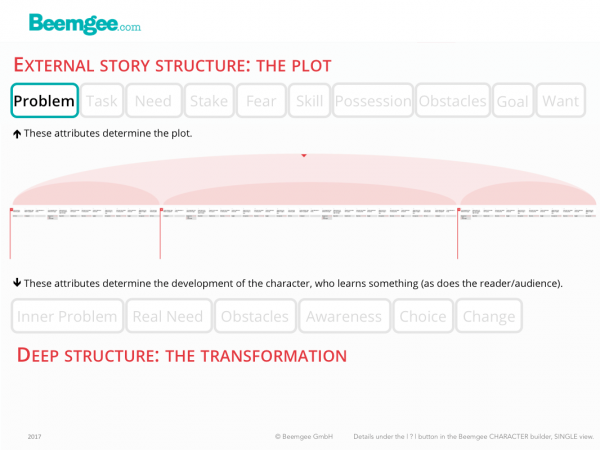
The external problem of the main character triggers the plot. It is shown to the audience as the incident which eventually incites the protagonist to action.
In some genres this is easy to see. In crime or mystery fiction, the external problem is almost by definition the crime or mystery that the protagonist has to deal with.(more…)
Stories are about people. Even the ones about robots, or rabbits, or whatever.
If you’re thinking about composing a story, you will probably have some characters in mind that will be performing the action of the story. In stories, action and actors (in the sense of someone who does something) are pretty much the same thing looked at from two differing perspectives, as we have noted in our post Plot vs. Character.
What sets characters in fiction apart from people in life is that characters tend to fulfil narrative functions in their story. People, on the other hand, live their lives by acting naturally according to the dictates of their personality. A story is a more or less enclosed unity, while an individual’s life is part of a greater whole. Only in retrospect do we sometimes overlay a narrative onto the biography of an individual – because we tend to feel happier when we perceive structure or direction in the lives of others or indeed our own. We can extract more meaning out of a life that can be told with structure and direction. In fact, there is no way of recounting a person’s biography without making choices concerning structure. If we’re honest, even the choice of which events to relate and how to relate them injects a fair amount of fiction into the story of a life, especially when that life is our own as we tell it to others or ourselves.
Many stories focus primarily on one protagonist. In fiction at least, the protagonist is usually wiser at the end of the story than at the beginning. The(more…)








